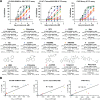Design of a Fluorescence Polarization Probe for Enterovirus 2C Proteins
- PMID: 40542722
- PMCID: PMC12333363
- DOI: 10.1021/acs.jmedchem.5c01219
Design of a Fluorescence Polarization Probe for Enterovirus 2C Proteins
Abstract
Enteroviruses (EVs), such as EV-D68, EV-A71, and CVB3, cause significant human disease; yet, no antivirals are currently approved. The highly conserved 2C protein, an essential AAA+ ATPase and helicase, is a prime antiviral target; however, it lacks suitable assays for inhibitor screening. Here, we report a fluorescence polarization (FP) assay using a rationally designed probe, Jun14157, which binds a conserved allosteric site in 2C with high affinity. This assay enables the quantitative assessment of binding to diverse 2C inhibitors with high signal-to-background ratios, DMSO tolerance, and a strong correlation between FP Ki and cellular EC50. Using this platform, we validated hits from virtual screening and identified two novel inhibitors, Jun15716 and Jun15799. This FP assay offers a robust and scalable tool for the mechanistic characterization and high-throughput screening of 2C-targeting antivirals.
Figures








Similar articles
-
Antiviral Peptides Targeting the Helicase Activity of Enterovirus Nonstructural Protein 2C.J Virol. 2021 May 24;95(12):e02324-20. doi: 10.1128/JVI.02324-20. Print 2021 May 24. J Virol. 2021. PMID: 33789997 Free PMC article.
-
Discovery of A-967079 as an Enterovirus D68 Antiviral by Targeting the Viral 2C Protein.ACS Infect Dis. 2024 Dec 13;10(12):4327-4336. doi: 10.1021/acsinfecdis.4c00678. Epub 2024 Nov 22. ACS Infect Dis. 2024. PMID: 39578369
-
A rationally designed 2C inhibitor prevents enterovirus D68-infected mice from developing paralysis.Nat Commun. 2025 Jul 1;16(1):5987. doi: 10.1038/s41467-025-61083-8. Nat Commun. 2025. PMID: 40593720 Free PMC article.
-
The Black Book of Psychotropic Dosing and Monitoring.Psychopharmacol Bull. 2024 Jul 8;54(3):8-59. Psychopharmacol Bull. 2024. PMID: 38993656 Free PMC article. Review.
-
[Volume and health outcomes: evidence from systematic reviews and from evaluation of Italian hospital data].Epidemiol Prev. 2013 Mar-Jun;37(2-3 Suppl 2):1-100. Epidemiol Prev. 2013. PMID: 23851286 Italian.
References
-
- Fall A., Kenmoe S., Ebogo-Belobo J. T., Mbaga D. S., Bowo-Ngandji A., Foe-Essomba J. R., Tchatchouang S., Amougou Atsama M., Yengue J. F., Kenfack-Momo R.. et al. Global prevalence and case fatality rate of Enterovirus D68 infections, a systematic review and meta-analysis. PLoS Negl Trop Dis. 2022;16(2):e0010073. doi: 10.1371/journal.pntd.0010073. - DOI - PMC - PubMed
MeSH terms
Substances
Grants and funding
LinkOut - more resources
Full Text Sources

